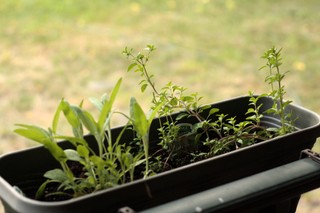How to group indoor herbs together for the best results

Growing plants indoors offers many benefits to both novice and experienced gardeners alike, often triggering a desire to grow as many plants as possible. Fortunately, there are many herbs that grow well together while simultaneously increasing the overall health of all of the plants, and making the gardening process easier.
Companion planting
The practice of growing plants together to synergistically improve one another’s growth[1] is known as companion planting and has been popular since the very early days of agriculture. Companion planting is a natural way to increase the health of herbs planted in fairly close proximity to one another.
When planted closely, companion plants develop symbiotic relationships enhancing the growth of both plants and sometimes all of the plants in their vicinity. These symbiotic relationships may manifest whether the herbs are planted in separate containers or in one, large container; the relationship does not need shared growing media to exist.
Companion planting also works very well with container-grown herbs because they are generally light feeders of fertilizers and/or nutrients. Their tendency to not deplete soil nutrients as quickly as other indoor plants makes them suitable to be grown together in shared containers.
Benefits of grouping herbs together
People are often unaware that growing a group of herbs is easier, and has benefits over growing one or two lone plants. They assume more plants equals more work, and shy away from increasing their cache because of the perceived greater difficulty.
Some of the benefits include:
- Grouping herbs together promotes health amongst all of the companion plants.
- Planting herbs together in containers takes up less space than using individual containers for each plant.
- Certain herbs contain chemical properties which can repel or deter pest insects,[2] providing natural protection to the entire group of plants. For example, chives are known to repel aphids; basil plants repel a handful of harmful insects as well as mosquitos.
- The flavor of neighboring plants may be enhanced.
- Growing plants together increases the relative humidity levels amongst all of the plants, contributing to a better-suited growing environment.

The enthusiast's guide to herbs
We’re proud to present our new e-book, The Enthusiast’s Guide to Herbs! Learn everything you need to know about growing and caring for herbs indoors, including in-depth info cards for the 35 most commonly grown herbs.
Click the link below to find out more!
Different ways to group herbs together
When deciding on how to group your herbs together, there are a couple of different ways you can amass your plants. Some gardeners choose to group them based upon similar light requirements, watering needs or container requirements.
Light requirements
Plants can be grouped together based upon the amount and/or type of light they prefer. Organizing or grouping them in this manner is one of the best ways to arrange them since light drives photosynthesis, resulting in foliage growth.
Light exposure
There are three primary ways to classify how much light exposure herbs need during the day: full sun, partial sun/partial shade, and full shade plants. These classifications are based upon the hours of light they need daily for growth. This light exposure doesn’t have to be continuous, but rather it can be broken up throughout the day as long as the minimum amounts are met.
Full sun plants require a spot receiving six or more hours of direct sunlight each day. Many herbs are classified as full sun: rosemary, lemongrass, sage, marjoram, oregano, and most microgreens. South windows are the best spot for full sun plants.
Partial sun and partial shade requirements are fairly interchangeable and mean the plant needs between four and six hours of direct sun daily. Partial sun plants prefer as close to the six hours of sunlight as possible; partial shade plants prefer less light, while still hitting the minimum threshold of four hours of sun. East or west-facing windows are great locations for partial sun or partial shade plants like catnip, chamomile, dill, and fennel.
Full shade plants want less than four hours of direct sunlight each day. They thrive with filtered sunlight or some direct sun in the early morning. North facing windows are appropriate locations for the following plants that grow well in full shade: mint, parsley, cilantro, thyme, chives, and lemon balm.
Direct vs. indirect light
Along with the amount of light exposure herbs need for growth, they can also be grouped by whether they prefer direct or indirect sunlight when grown indoors. Most herbs prefer direct light, making them great specimens for growing indoors on a windowsill.
Direct light comes through south windows all day long and west-facing windows during the middle part of the day. This light is bright and the sunlight falls directly on the foliage of your plants. For many houseplants, this light is too intense, but herbs and microgreens typically withstand direct sunlight with little ill effects. During the afternoon when the sunlight is the most intense, make sure herbs aren’t being scorched by the sunlight if close to windows as the glass can intensity already powerful light rays.
Indirect light is bright light without direct sunlight, usually found as you move away from the rays streaming in through the windows towards the center of rooms. Most houseplants prefer bright, indirect light when grown indoors but full shade herbs perform well in indirect lighting conditions.
Watering needs
Herbs can also be grouped together based upon their soil moisture preferences. Meaning how they like soil conditions between waterings.
Moisture-loving plants prefer their potting soil to stay slightly moist – but not saturated – between waterings. They should be watered before the containers are allowed to dry out completely or the herbs will suffer from stress responses that result in reduced growth or subpar plant health. Basil, parsley, coriander are a few herbs that like wetter soil conditions and work well when grouped together.
Some plants simply don’t like their growing media to be damp or moist but instead want it to stay more on the drier side. They typically like longer stretches between waterings, allowing the top one to inches of the container to dry out before watering the plant again. Bay, chives, fennel, lavender, lemon balm, marjoram, rosemary, thyme, sage, and oregano prefer drier, sandy soils.
Container size
Another great way to group herbs together is to consider the container size needed to grow the types of herbs you desire.
Plants that have deep root systems can easily be grouped together in a deeper container to allow for proficient, healthy root growth. Some examples of deep-rooting herbers are dill, fennel, cilantro, and parsley.
Herbs with shallow root systems grow well together in shallower, wide containers. Most herbs have shorter roots and grow sufficiently in shorter containers, but mint, basil, rosemary, oregano, tarragon, and thyme make do with as little as six inches of depth for their root systems.

Plants that grow well together
There are some plants that naturally grow well together, and are a great place to start if you don’t want to think about or research the growing conditions herbs prefer. It takes the guesswork out of grouping specimens.
It’s usually a safe bet to group herbs together that are known to originate from a certain region or culture. As an example, Mediterranean herbs such as oregano, sage, thyme, rosemary, and marjoram are adapted to climates very similar in nature and grow well together.
A couple of plants are also known to get along with almost anything they are planted in close proximity to.
Sometimes called the “plant’s physician” or a “nurse plant”, chamomile seems to help boost the health of ailing or sickly plants growing around it. The strong scent from the essential oils also acts as a natural deterrent to insect pests.
Calendula is another excellent herb to grow with other plants through its ability to promote beneficial soil microbes and fungi.
Situations to avoid
Most herbs play well with others, and can successfully be planted en masse with others. Care needs to be taken though when dealing with mint. Anyone who has grown it outside in their garden knows how quickly it can take over any area it has access to. Even when grown in containers it will take over any available space. Due to this, it’s best to not grow mint with other plants but to instead grow it by itself. Mint is also a known enemy of parsley.
When planting herbs together as companion plants, make sure to allow enough space between plants. Grouping them too closely causes them to compete with one another for resources such as light, water, and nutrients, having a negative impact on overall plant growth.
Conclusion
Planting herbs together via companion planting provides many benefits to indoor gardeners. Companion planting of herbs encourages sustainability, helping to reduce insect problems, and other natural stressors while improving the overall health and growth of all plants. Herbs can be grouped together in a variety of different ways such as light requirements, watering needs, or known symbiotic relationships between given types making it easier overall to care for plants versus when they are grown singularly.

Join our email club—get printable info cards free!
Sign up to receive our newsletter and get access to 10 printable plant info cards from our e-book for free. Also receive:
- $4 discount code for our Guide to Herbs e-book
- Semi-weekly plant inspiration & bite-size tips and tricks
Franck G. (1983). Companion planting: Successful gardening the organic way. Wellingborough, England: Thorsons Publishing Group. ↩︎
Parker, J. E. Snyder, W. E. Hamilton, G. C. & Rodriguez-Saona, C. (2013). Companion planting and insect pest control. In. S. Soloneski & M. Larramendy (Eds.), Weed and Pest Control - Conventional and New Challenges (pp. 1-30). London, United Kingdom: IntechOpen Limited. doi: 10.5772/50276 ↩︎
